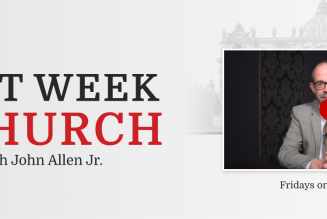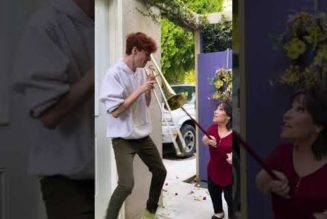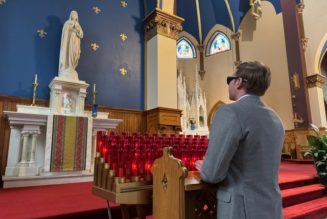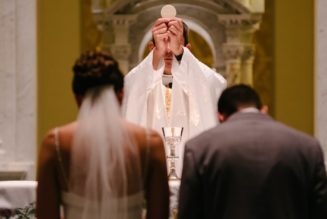
Throughout this week, I have been following the online reports about the remarkable day-after-day revival gatherings that are taking place at Asbury University in Kentucky.
If you know about Methodist and Holiness movements, it isn’t surprising that this kind of spiritual earthquake would take place — again — at this location (here are some Asbury library resources on the history of earlier revivals).
Years ago, I went to Asbury for a speaking engagement. I noticed that there were tissue boxes placed a regular intervals along the sanctuary prayer rail-kneeling area. In other words, this is a campus in which it is normal for worshippers to kneel in sorrow/joy (often part of the same experience) while offering prayers of petition or repentance. This is part of the spiritual DNA of this community.
While reading social-media offerings about the revival, I also ran regular Google News searches (sample here) to see if journalists — including those at elite publications — have been covering this event.
The pickings have been rather lean, for reasons we discussed during this week’s “Crossroads” podcast (CLICK HERE to tune that in). I found myself, in a kind of time-travel experience, imaging myself attempting to convince a newspaper editor that this mysterious, spiritual outbreak was a BIG. NEWS. STORY.
This led me, believe it or not, straight to “The Screwtape Letters,” by C.S. Lewis, the famous Oxford scholar and Christian apologist. In this classic, global bestseller a master demon writes letters to his nephew Wormwood, an apprentice in need of advice on how to lead a human soul into hell. The relevant text, in my musings on the “news value” of this Asbury revival, is Letter 25. The key passage states:
“The real trouble about the set your patient is living is that it is merely Christianity. … What we want, if men become Christians at all, is to keep them in the state of mind I call ‘Christianity AND.’ You know –– Christianity and the Crisis, Christianity and the New Psychology, Christianity and the New Order, Christianity and Faith Healing, Christianity and Psychical Research, Christianity and Vegetarianism, Christianity and Spelling Reform. If they must be Christians let them at least be Christians with a difference. Substitute for faith itself some Fashion with a Christian colouring.”
In other words, national journalists may be trying to figure out what the “AND” is in this story.
If a “revival” is not news, what if this was “revival and smartphone sin”? Maybe “revival and Christian nationalism”? That would work. How about “revival and social justice,” since that is a relevant Methodist theme from the past? Does anyone doubt editors would fund coverage of repentant students, if they were confessing struggles with gender dysphoria?
GetReligion readers will not be surprised to know that this Asbury revival — which may be spreading, via social media — is news in “conservative” and “religious” publications. Here is the top of an update from former GetReligionista Mark Kellner, reporting for The Washington Times:
A Christian university’s weekly chapel service in Wilmore, Kentucky, has turned into an impromptu nonstop prayer meeting over the past week, drawing visitors from across the country, attracting millions of views on social media and fueling talk of a nationwide religious revival.
The Feb. 8 morning worship at Asbury University included a sermon by the Rev. Zach Meerkreebs, a campus minister, on “Becoming Love in Action.” After the message, students gathered to pray.
As of Thursday, they hadn’t stopped.
Videos of tearful worshippers singing hymns and offering personal testimonies have gone viral on TikTok, Instagram and YouTube, racking up millions of views and inspiring carloads of visitors to descend on Wilmore, population 6,000, to share in what some are calling a movement — and the spiritual explosion hasn’t stopped at the city line.
Schools including Lee University in Cleveland, Tennessee; Cedarville University in Cedarville, Ohio; Oral Roberts University in Tulsa, Oklahoma; and the University of the Cumberlands in Williamsburg, Kentucky, are among campuses reporting extended prayer-and-worship sessions attributed to interest in the Asbury event.
It is possible that editors may approve some kind of coverage of this event if it veers into their own zip code. As you would expect, there has been some coverage — but surprisingly little — in Kentucky. See this early television report.
So far, it appears that the magic news formula has been “revival and TikTok,” or some other social-media connection. See this bite of an NBCNews report, which has gained some traction online:
On TikTok and Instagram, videos hashtagged “Asbury Revival” are racking up millions of views. At the time this article was published, the hashtag #asburyrevival had 24.4 million views on TikTok.
The phrase “spiritual revival” can carry different meanings; in Christianity, they generally refer to a resurgence in interest in the church from believers and nonbelievers. Many attendees of the Asbury gathering say they were drawn by a spiritual presence they felt was at the event.
In the TikTok videos of the event, some people are seen crying to worship music, with hands extended high, while others group up and place hands on those seeking prayer. The response of many TikTokers has gone beyond the typical “like” or comment on the videos, which in some cases have stirred viewers to make the trek to Asbury for themselves.
At some point, journalists face a practical question: Do we actually have to LISTEN to the contents of this ongoing service (since much of it is streaming online)? I mean, might there be clues as to the nature of this phenomenon contained in the WORDS of the sermons, prayers, scripture readings, personal testimonies and hymns? #DUH
But that would take lots of time. I looked up one YouTube post on the revival and it is five hours long. Will editors approve this kind of research?
It is also interesting to note that a few journalists are turning to “revival” experts and historians — on campuses far from Asbury. This is a bit strange, since Asbury University and Asbury Seminary contain nationally known experts on these subjects and, well, it’s possible that they have checked out some of the current revival services?
Christianity Today offered this excellent report from Thomas H. McCall, who teaches theology at the seminary, with this headline, “Asbury Professor: We’re Witnessing a ‘Surprising Work of God.’ “
Also, the global Methodist renewal organization Good News is based near the campus. Its website contains this helpful essay: “What happens in revival?” The author? Check out this set of credentials:
Stephen A. Seamands is Professor Emeritus of Christian Doctrine at Asbury Theological Seminary in Wilmore, Kentucky. He served as the Professor of Basic Christian Doctrine at Asbury Seminary for close to 40 years.
While this story is unfolding in a Methodist context — on a campus that plays a strategic role in global debates about the future of United Methodism — there has been some interesting coverage in Baptist Press, of all places. Here is a sample, noting the kinds of questions that are being raised about this event:
Participants soon described testimonies of what was going on at Asbury as revival. … Sadly, it wasn’t long before many Christians took to social media to question the validity of what was happening at Asbury being described as revival.
“On what basis are we calling this a revival?”
“Emotionalism, singing and flag waving are not revival!”
“No one will know whether this is a revival or not until the fruit of it is examined years from now in the lives of people who are not there on campus.”
Lots of people — in a variety of Christian traditions — are truly interested in what is unfolding at Asbury.
I believe that part of this based on concerns about the spiritual needs and struggles of the current generation of students in America.
Yes, I know that this could become a “revival AND” hook for coverage. Still, I suspect that this is part of the picture.
<div class="sqs-block embed-block sqs-block-embed" data-block-json="{"width":550,"height":null,"hSize":null,"html":"
Here's my first full post on the new After Babel substack: I present the evidence that an epidemic of mental illness began among American teens around 2012.
It's not just changes in self-report.
And it's not just "kids these days." https://t.co/TwPArbVpbl pic.twitter.com/oDB3BiEnBa— Jonathan Haidt (@JonHaidt) February 8, 2023
\n","url":"https://twitter.com/JonHaidt/status/1623286588389134337","resolvedBy":"twitter","floatDir":null,"providerName":"Twitter","customThumbEnabled":false}” data-block-type=”22″ id=”block-yui_3_17_2_1_1676641545351_325473″>
Here’s my first full post on the new After Babel substack: I present the evidence that an epidemic of mental illness began among American teens around 2012.
It’s not just changes in self-report.
And it’s not just “kids these days.” https://t.co/TwPArbVpbl pic.twitter.com/oDB3BiEnBa— Jonathan Haidt (@JonHaidt) February 8, 2023
<div class="sqs-block embed-block sqs-block-embed" data-block-json="{"width":550,"height":null,"hSize":null,"html":"
In my second substack post, I show that the new CDC report that everyone is talking about actually shows that Covid did little to change the pre-existing trends in teen mental illness. Teens were already socially distanced by 2019.https://t.co/wEFtXPAZWx
— Jonathan Haidt (@JonHaidt) February 16, 2023
\n","url":"https://twitter.com/JonHaidt/status/1626185429010481152","resolvedBy":"twitter","floatDir":null,"providerName":"Twitter","customThumbEnabled":false}” data-block-type=”22″ id=”block-yui_3_17_2_1_1676641545351_323120″>
In my second substack post, I show that the new CDC report that everyone is talking about actually shows that Covid did little to change the pre-existing trends in teen mental illness. Teens were already socially distanced by 2019.https://t.co/wEFtXPAZWx
— Jonathan Haidt (@JonHaidt) February 16, 2023
I’ll end with this first-hand Facebook report from an unlikely source — an Eastern Orthodox priest.
After spending some time in the Asbury sanctuary, Father Justin Patterson of St. Athanasius Orthodox Church in Nicholasville, Kentucky, offered the following observations:
Over the past 5 days or so I have been bombarded by questions from my FB friends of all religious stripes everywhere about the evangelical-style revival that has broken out in my metaphorical backyard — at Asbury University in Wilmore, Kentucky.
People ask me, “Is it real? Is it fake?” Here’s what I observed: singing, Bible reading, and some exhortations. In full disclosure, the music and the style of the exhortations are not my cup of tea. (I was like, “where are all the rich Wesleyan hymns? The music was contemporary choruses over and over. Yipes.)
But I observed sincere, Protestant people doing their best to connect to God — and in their own tradition. This gathering did not speak my language, but I would not speak against it. To paraphrase St. Augustine, I can say where the Church is and where God is active (in the Sacraments of the Church,) but I hesitate to say “God is not in this” and to deny his activity in something.
My mind goes to Mark 9, where the Lord responds to the disciples being scandalized about those doing works in Jesus’ Name who are not part of the apostolic company. He basically rebukes his disciples and tells them “those not against us are with us.” (In Matthew 9 there is a similar verse but inverted. The context is a little different, too.) But my point is that it might be wise to consider that God may use such movements.
But with the caveat (as always) that “You will know them by their fruits.” It’s even possible the movement could be mixed: with genuine spiritual elements being mingled with human or delusional things. (Those bad things would not necessarily negate the good for all those attending.)
I suppose my stance is slightly skeptical but with an open mind and a wish that the movement could lead to real repentance and spiritual growth. God is God and I am not. (Thank God!)
Stay tuned and, please, let me know if you see important coverage in major media.
Enjoy the podcast and, please, pass it along to others.
FIRST IMAGE: Actor-producer Max McLean in the off-Broadway C.S. Lewis On Stage production of “The Screwtape Letters.”









